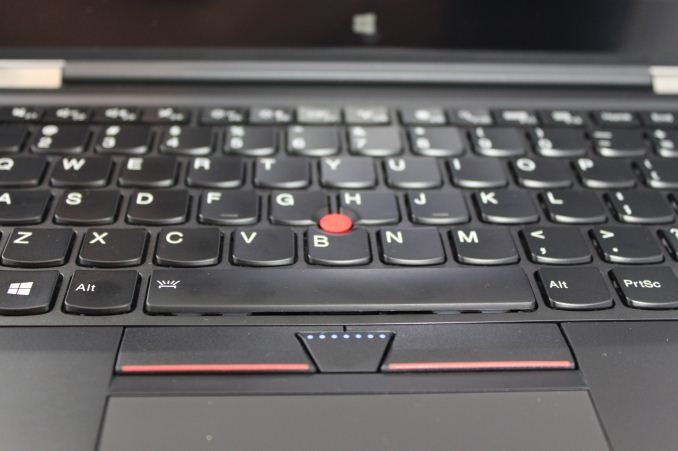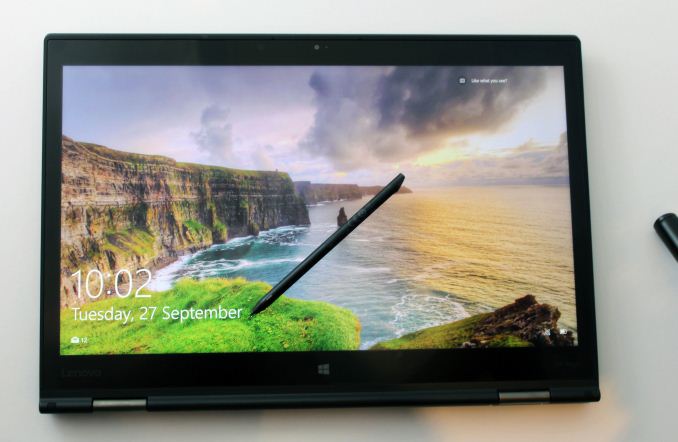The Lenovo ThinkPad X1 Yoga Review: OLED and LCD Tested
by Brett Howse & Brandon Chester on September 29, 2016 11:30 AM ESTFinal Words
Wrapping up, there’s quite a bit to go over with the ThinkPad X1 Yoga. Lenovo has done a great job continuing to make the X1 series thinner and lighter, and while some may question where that ends, anyone who needs a very portable laptop will appreciate this. Speaking of portability, Lenovo is one of the few brands to offer LTE connectivity in their ThinkPad lineup, further increasing the mobility of this notebook.
The X1 Yoga does a great job branching out from the X1 Carbon, which is itself an Ultrabook with positive characteristics. But the Yoga further builds on the Carbon by morphing that basic design into a thin and light two-in-one notebook using the Yoga hinge. For those looking for a notebook first, with some extra capabilities of being a touch device or tablet, the Yoga style devices from our experience win hands down over detachable convertibles. Compared to detachables, the Yoga devices have a much better weight distribution when used as a laptop, and Lenovo has included the ability to lock the keyboard when rotated, making it much better to hold and use in any of the non-laptop modes.
For performance, the battery life is reasonable by 2016 standards. One might suggest that with a premium line, a jump in platform efficiency would be a good aspect for the brand to move it into the higher echelons. Lenovo have been middle of the road against the competition in overall efficiency for some time - for some of the notebooks with large batteries this isn’t an issue, but on a size constrained notebook like the X1 Yoga, the effects are felt more quickly. The 52 Wh battery is a decent size for this size of notebook, but it isn't best-in-class.
We were lucky enough to be sampled both the LCD and OLED models to test. Lenovo is one of the first out of the gate with an OLED notebook, with a number of OLED designs on the market focusing on tablets, smartphones and VR. OLED technology has advantages that can really bring a wow factor to this market. The amazing contrast ratios of OLED easily outclass any LCD. While the OLED was advertised as highly accurate with specific options available, and it was much better than the LCD model, it still was not as good as some of the better notebooks we've seen over the past year or suited for professional use without user calibration tools. The color management software is comprehensive, so with some calibration the OLED on a per-unit basis from the factory would likely put the product ahead of the field in color accuracy.
It's hard to argue with the ThinkPad look, since it is so well known and Thinkpad customers demand it. Branding is difficult, and although some may find the ThinkPad lineup to be a bit low key, the matte black finish and design makes the laptop recognizable as a ThinkPad. Being a ThinkPad, it should be more durable than consumer notebooks, with a magnesium alloy chassis and military spec testing done to ensure it operates where many other laptops may struggle. For instance, the X1 Yoga, despite being convertible and despite having a lift and lock keyboard, still offers the spill-resistant keyboard. The polycarbonate exterior is pretty strong, especially where it is reinforced with carbon fibre, and there is a lot of durability there.
While the X1 Yoga keyboard can’t match some of the other thicker and heavier models like the T460s in key travel, it still has a great feel. The trackpad works well, and features a glass surface so it’s nice and smooth, which Lenovo combines with TrackPoint for those that use it.
Overall, the X1 Yoga is a good convertible. Lenovo has managed to make it thinner and lighter than the original X1 Carbon, yet still offer the versatility of the Yoga hinge. It's a solid offering from Lenovo. If thin, light, convertible, and business-class are all things you need, the X1 Yoga should be considered.













84 Comments
View All Comments
lefenzy - Thursday, September 29, 2016 - link
The 520 is fine for anything outside of gaming. And light gaming like CS:GO is perfectly ok to. You don't have to play at native resolution.BrokenCrayons - Thursday, September 29, 2016 - link
Playing around with video games wasn't the focal point of that comment. I'd hardly consider it relevant in the modern world when gaming is a better chore for purpose-built hardware (consoles) or mobile scenarios where a person is compelled to wait for something for a few minutes (tablets/phones).That's why I said, "1080p is a stretch for the 520 doing anything intensive." That statement covers a wide range of other tasks that stress a graphics processor but have nothing to do with "playing" and everything to do with working.
lefenzy - Thursday, September 29, 2016 - link
Majority of users just do internet, office, and media work, with primary stress on the CPU. I wouldn't expect anything more from an ultrabook.BrokenCrayons - Friday, September 30, 2016 - link
Your personal expectations may not align with the expectations of other people. It's a computer and therefore will be subjected to a variety of different workloads. Just because it meets Intel's specs for battery life and thickness doesn't grant it immunity from user demands."Sorry end user, I'm an ultrabook so you simply can't perform tasks x, y, and z at all." -- Sounds a bit silly doesn't it? It sounds even more silly when a certain category of computing tasks was performed on say a old 386DX running at 25MHz packing 4MB of 30-pin RAM in 8 512KB sticks. But oh no, a Thinkpad X1 can't perform the modern version of that chore. Why? Because ultrabook!
lefenzy - Monday, October 3, 2016 - link
you're going off the railsMrSpadge - Thursday, September 29, 2016 - link
What could you possibly want to work with such a device where the GPU and screen resolution matter?Video re/encode: it's the video resolution, not the screen
CAD, 3DS etc.: good luck with Intel OpenGL drivers to make it run at all. And if it does, a factor of 2 or 3 more performance from the Iris / Iris Pro won't change the experience much.
GPU computing: Intel not supported, driver bugs etc.
Some corner case benchmark: well, maybe it helps here
BrokenCrayons - Friday, September 30, 2016 - link
"What could you possibly want to work with such a device where the GPU and screen resolution matter?"Quite a few computer users spend quite a bit of time fretting over GPUs and screen resolution. Evidence can be found by reading computer reviews, monitor reviews, GPU reviews, advertisements for computers, technical forums, or just by asking around. In modern times, we even spend significant time discussing the graphics processors and screen resolutions of our telephones. I can't think of many situations where those two metrics aren't relevant concerns.
MrSpadge - Friday, October 7, 2016 - link
Just because it's listed in specs and some people get crazy about it doesn't mean it really matters. when was the last time you badly wanted to run a game on your phone but your GPU was too slow?Samus - Friday, September 30, 2016 - link
it's important to note most modern Thinkpad's do NOT meet many MIL-STD-810G specifications, presumably including this Yoga since the previous Thinkpad Yoga's didn't meet any of them. The most durable model, the T series, meets only 8 of the specifications and most of them mildly in comparison to the competition. For example, the Thinkpad T460 is guaranteed to pass the mechanical shock test (no details given on what the testing parameters are) precisely 18 times, giving the perception they are cherry picking a number.By comparison, the weakest modern Elitebook, the 8460\8470 (predates the 94xx/8xx/10xx series) bested the test 40 times at a distance of 3 feet and a repetition frequency of 30 seconds. It also did it while POWERED ON, and did not turn off. All these details are missing from the Lenovo data.
Additionally, certain tests, such as dust tests, are also cherry picked results by Lenovo, using a 6 hour cycle. By comparison, they use the MIL-STD guideline of a 24 hour continuous test, not four 6-hour tests.
Lastly, a number of tests are missing. Important ones, such as the impact pressure test (1500G) aka the "crush" test which is comically reproduced on YouTube by running over Elitebooks with a VEHICLE of some sort. But this could conveniently fall into Lenovo's category of high-vibration "multiple tests" again with no details or data provided.
Modern Lenovo Thinkpads are more in-line with HP Probooks and Dell XPS's. If you want most of the 810G compliancy the only economical devices are Elitebook 8xx/10xx series, various Dell Latitude 64xx\65xx series and the Precision 7000 series. It's important to note that Thinkpad's from over a decade ago were substantially more durable than the modern equivalent. At the same time, the competition, specifically HP, Dell and Panasonic, have all improved their durability every subsequent generation (although HP has been sacrificing durability for aesthetics in some recent models such as the 1020/1040.)
Comically, Lenovo sells various "shells" or cases for their Thinkpads to improve durability. My favorite one is the "healthcare" case. Look it up for a good laugh.
Also worth pointing out because a lot of people say the competition doesn't offer a "Yoga" competitor is yes, they do. The "convertible" form factor has existed for nearly 20 years. Windows 98 PC's came in convertible "tablet" options. The Elitebook 810G (11.6") is probably the most modern version of a convertible, offering all the flexibility of a Yoga with more durability and a lower price.
lefenzy - Thursday, September 29, 2016 - link
IMO, you should avoid language like the Fn and Ctrl keys are swapped from "default" arrangements as there is no default. Thinkpads have had Fn on the left corner for forever, and so do macs.Also the placement of Print Screen where there should be the Menu key remains inexplicable.